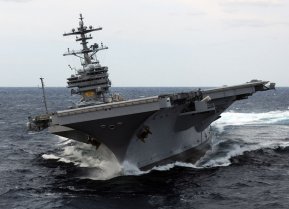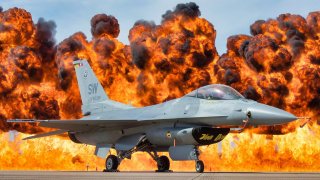Ukraine's F-16 Fighters: Evaluating Their Impact Against Russian Invasion
Initially, analysts pointed to extensive training time and delivery processes as reasons not to deliver F-16 Fighting Falcons to Ukraine. Additionally, these fourth-generation fighters require much more maintenance than the average Soviet-era fighter Kyiv’s pilots are used to flying.
Summary: This article discusses Ukraine's acquisition of 60 F-16 fighters from the Netherlands, Denmark, and Norway to bolster its defense against the Russian invasion. It provides an overview of the F-16's history, specifications, and capabilities. The debate over the F-16's suitability for Ukraine's current situation is explored, considering factors like training, maintenance, and the threat posed by Russia's S-400 missile systems. While some view the F-16s as a significant upgrade for Ukraine's air force, others raise concerns about their effectiveness in the ongoing conflict. The article highlights the potential long-term impact and NATO's technological alignment with Ukraine through the F-16 acquisition.
Ukraine’s 60 New F-16 Fighters—Can They Make a Real Difference?
When Russia first invaded Ukraine back in February 2022, the U.S. and its North Atlantic Treaty Organization (NATO) allies immediately pledged support for Kyiv.
From main battle tanks (MBTs) and munitions to cash funds and anti-tank weaponry, the U.S. has provided billions of dollars worth of military equipment to aid Ukraine’s defensive efforts.
While NATO allies have agreed to send over many of the items requested by Kyiv, some were more challenging to provide. For more than a year, Kyiv asked the White House to deliver modern fighter jets to the front lines.
The Biden administration repeatedly refused this request. However, a surprise policy reversal in 2023 was a turning point. The U.S. president told allies that he would support an international coalition to train Ukrainian pilots on Western fighter jets, paving the way for fourth-generation airframes to make their way to the frontlines eventually.
Today, the Netherlands, Denmark, and Norway are offering Ukraine 60 F-16s in the near future.
Will these airframes actually make a difference in a war that has been characterized as a never-ending stale-mate?
An overview of the Fighting Falcon
The F-16 was derived from the 1970s Lightweight Fighting Program and has remained a critical component of America’s aerial arsenal over the years. Following lessons learned during the Vietnam War, U.S. officials required an airframe with more robust combat performance.
After much trial and error, the YF-16 prototype was developed by General Dynamics and rolled out in 1973. Over the next year, America’s NATO allies Belgium, Denmark, and the Netherlands reached an agreement with the U.S. to order the winner of the LWF competition. By 1976, the YF-16 was declared the winner. The airframe’s lower operating costs, maneuver performance and greater range made it a standout.
Additionally, using the Pratt & Whitney F100 turbine engine for power was a plus since its use in the F-15 would mean lower engine costs for both programs.
F-16 Specs & Capabilities
The compact, multi-role fighter jet is highly maneuverable and can perform both air-to-combat and air-to-surface missions. Each Fighting Falcon features the Boeing joint helmet-mounted system and other enhanced technologies like up-look reticles and optical/inertial trackers.
In terms of ordnance, the F-16 is well-stocked. The F-16 possesses nine hardpoints for weapons payloads, one at each tip, one centerline under the fuselage, and three under each wing.
These fighters can carry an array of air-to-surface missiles, including Maverick, HARM and Shrike. Additionally, the fighters are equipped with Boeing Harpool and Kongsberg Penguin anti-ship missiles. To complement its hefty weapons-carrying capabilities, the Fighting Falcon is quite the racehorse.
The fighter can fly over 1,500 miles per hour with an operational ceiling of 50,000 feet. Moreover, the airframe has an operational range of over 500 miles.
How useful will F-16s be for Ukraine?
Initially, analysts pointed to extensive training time and delivery processes as reasons not to deliver F-16 Fighting Falcons to Ukraine. Additionally, these fourth-generation fighters require much more maintenance than the average Soviet-era fighter Kyiv’s pilots are used to flying.
Last year, a report by the U.S. General Accounting Office ranked the F-16 as one of the most challenging U.S. Air Force planes to maintain. Another key factor analysts point to when explaining why Fighting Falcons are not suited for Russia’s current invasion in Ukraine is the wrath of Moscow’ S-400 Surface-to-air missile systems (SAMs), which could leave the F-16 “completely unmatched.”
Proponents of providing Fighting Falcons to Ukraine claim that while these jets will not abruptly alter the course of the war, they are a major step up for the older planes Kyiv is currently flying and will, in the long run, prove to be a significant asset for the country’s defensive efforts. Down the line, if Kyiv uses these fighters to aid specific operations, it will have a better chance of success. Specifically, Ukraine’s pilots could use F-16s to gradually take apart Russia’s air defense umbrella around the battlefield to make room for more open-air operations.
As detailed by Reuters, the addition of F-16’s “locks Ukraine onto a technological path that NATO is currently on, what Ukraine has now is a dead end; It’s not going anywhere. If you want to have an air force in 10 years, it’s going to have to be F-16s or something similar.”
Since Ukraine launched its highly anticipated counter-offensive this summer, little significant movement has been documented on the ground. In fact, since February 2022, Russia has maintained about one-fifth of Ukraine in its grip while the front lines have remained relatively stagnant.
Hopefully, adding the 60 Fighting Falcons will help push Kyiv’s efforts further.
However, the true outcome that the delivery of these fighters will provide remains up for debate.
About the Author: Maya Carlin
Maya Carlin, National Security Writer with The National Interest, is an analyst with the Center for Security Policy and a former Anna Sobol Levy Fellow at IDC Herzliya in Israel. She has by-lines in many publications, including The National Interest, Jerusalem Post, and Times of Israel. You can follow her on Twitter: @MayaCarlin. You can email the author at [email protected].


